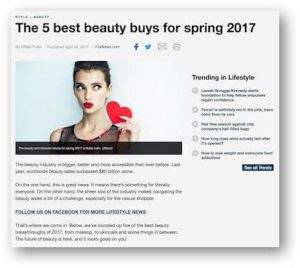What Do These “5 Beauty Buys” Say About World Cosmetics Growth?
This week, as we attend in-cosmetics Global 2017 in London, there are (obviously) countless conversations happening about an always-dynamic industry, but one that seems especially fluid and electric right now. Just some of the topics of various sessions at this year’s event?
- Winds of change: Reimagining growth in the global beauty industry
- The booming skin care market – Skin care trends and the ingredients within
- Brexit – What does this mean for the UK and EU cosmetics industry?
- And even a session addressing Using Artificial Intelligence (AI) to enable consumers to look younger.
 As you can tell, the headlong momentum of the personal care and cosmetics market is a huge discussion point for everyone, as manufacturers, formulators, distributors and marketers wrestle with everything from overall growth to the rapid expansion of segments like Halal cosmetics, which on its own is expected to reach $52 billion in sales by 2025.
As you can tell, the headlong momentum of the personal care and cosmetics market is a huge discussion point for everyone, as manufacturers, formulators, distributors and marketers wrestle with everything from overall growth to the rapid expansion of segments like Halal cosmetics, which on its own is expected to reach $52 billion in sales by 2025.Even the mainstream media is taking note, mentioning that growth in lifestyle/product stories like this post from Fox News about “The 5 Best Beauty Buys for Spring 2017.”
Cues about cosmetics growth
But what’s also interesting is how their 5 picks encompass key trends that are driving that worldwide growth:
- Anti-aging is a growth business, of course. And a product like the Rita Hazan Root Concealer Touch-Up Stick is one example of how to attack that massive opportunity, even if grey touch-up products have been around a long time and don’t get quite the attention of new skin treatment innovations.
- Nutricosmetics are represented by the Clinique Fresh Pressed Daily Booster with Pure Vitamin C 10%, which may be a mouthful to say, but hits all the right marks in appealing to consumers who are expected to drive sales in this category to $7.4 billion by 2020, with Europe as the biggest market, but the U.S. as the fastest-growing.
- Pricing: The five products listed as “best buys” are hardly low-end players, with $22 being the lowest price point among the lot.
The last point is important, since it shows just how willing consumers are to spend extra for products with higher-perceived quality, natural or health-related ingredients, and that deliver the utility they’re looking for: Providing a superior personal care experience, especially when it comes to fighting off the effects of aging.
Even if they’re from lower income segments, consumers are willing to spend more for products that meet the need. That desire, which is spreading globally, is fueling enormous growth and very healthy margins, which in turn fund the sort of innovation that’ll keep propelling growth.
